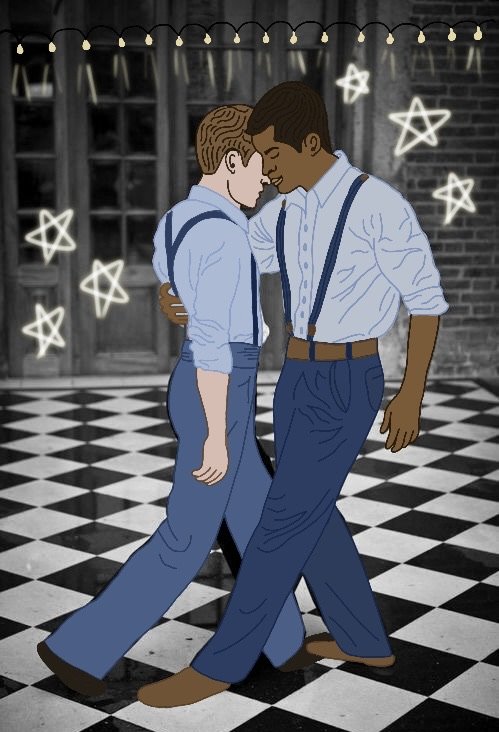Dancing Around Gender Norms
Dancing Around Gender Norms
written by griffin willner
Art by hailey kroll
I have vividly dreamed of my wedding day, particularly my first dance, since childhood. I remember gathering my animals in a line and sending them down the aisle one by one on multiple occasions. Dance, to me, is a tying of souls. I imagine placing my head on my husband’s shoulder covered by a dark, fancy fabric that perfectly matches my outfit. I picture moonbeams glistening as heavenly lights reflect off our golden rings, symbolizing our union as a reality. I see our bodies parallel to one another and adjacent to our spirits, swaying in tandem. Really, my perfect scene only has two problems: first, I am not a very smooth dancer, and second, how are people outside of heteronormative gender roles supposed to partner dance?
After coming out as gay eight years ago on October 20, 2016, I began navigating the uneasy terrain of seeking same-sex romance; a love that does not fit into the traditional binary gender norms of our society. When I walk the tightrope of my queer romances, I find it difficult to understand which guidelines do and do not apply. Queerness allows for freedom, but the lack of standardization can be confusing. Even the simplest norms, like “Who are my friends supposed to be?” can make everyday interactions complex; add romance into the mix and it becomes a whole other monster.
I find that a great example can be found in the realm of dance. In traditional partner dances—an act that portrays carnal passion—heteronormative rules decide which person should hold and which person should be held. Men lead and women follow. This practice is stereotypical, obviously, but the truth is that many heterosexual couples follow this norm. For queer couples, what are we supposed to do?
I remember once pretending to dance with a man while alone in his apartment, dimly lit by the television. I put my hands on his hips as I had done so many times with my femme-identifying friends, but I felt a sense of discomfort. His hands then went to my hips and we bumbled around before bursting into laughter, accompanied by “Fade Into You” by Mazzy Star. Though intimate and silly, the interaction demonstrated an utter lack of exposure.
I have always loved dancing. My background, like so many other queer folks, began in music and musical theatre. While the arts are a common interest in the LGBTQ+ community, institutions of the arts do not often portray queer romance through dance. I remember seeing ballet performances such as The Nutcracker during my closeted childhood and wishing to be held by the male performers opposite Clara or the Snow Queen. In the darkness of the theater, I would picture myself spinning in pirouettes until I fell into my lover’s arms—it all seemed so romantic! That image faded as I realized I was not “a Clara” nor “a queen,” at least not in the hetero definition of the word. If I had known of any men dancing arm-in-arm, hand-in-hand, perhaps I would have felt less taboo.
In high school, at the height of my theater career, I had the opportunity to be directed by an openly queer woman and professional dancer-choreographer, Adriana Pierce. Pierce pushed me to twirl, contort, express, connect, and feel more joy than I ever had while dancing. Like I said, dancing was not my forte. Though I have moved beyond dancing under stage lights, I have not yet lost my belief in the artistic power of dance.
Since then, Pierce founded an initiative titled Queer the Ballet. This project has created a ballet space for queer women as well as trans and nonbinary performers. Using works by queer artists and performed by queer dancers, she shows that ballet and dance, like other artforms, can include voices outside of traditional binaries. Furthermore, this initiative breaks the traditions of the male-female pas de deux, the partner dance of the style. When I see videos of their performances, I am awestruck by the connection and the chemistry of the pairings. It gives me hope that the question of how gay couples dance will arise less and less as more representation emerges.
I highly recommend that any readers, especially queer ones, check out works from this initiative. Seeing these images, the question of rules exits stage right. I imagine myself in the arms of my future partner surrounded by my family and friends as my fears fall away. Partner dances, after all, should be about connection. All of us, queer or otherwise, deserve to feel love through expressions of dance, and we deserve to know that it is possible! It may seem miniscule, but when we interrogate each of the ways queer couples fall out of bounds, we see that representation is an important tool for education. It might just save my wedding day!

